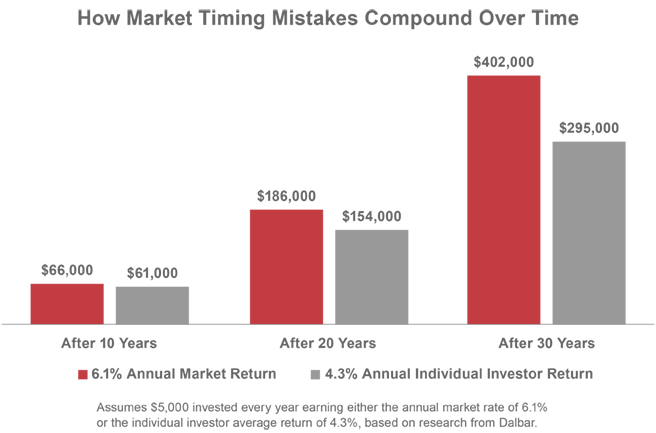By Mark Stoeckle
July 1, 2020
Many investors probably felt justified in wanting to reduce their equity exposure in late March. After all, stocks had lost a third of their value amid the market shock caused by the coronavirus (COVID-19) pandemic. A key Federal Reserve official predicted U.S. unemployment would soon hit a record 20%. And for the first time in generations, economists began uttering the word depression to describe what might soon happen to the economy.
The truth is, investors can rarely predict the best time to exit stocks, as the recent market sell-off shows. In fact, we believe you are far better off remaining disciplined and staying invested in the markets through good times and bad.

However, from March 23 to the end of May, the S&P 500 index actually soared 37%. Investors who panicked and bailed on stocks ended up locking in the paper losses they suffered from earlier in the year and then missed out on one of the strongest short-term surges in history.
It’s an all-too-common story: Investors who think they can time the market by selling when things look dicey are proven wrong. The truth is, investors can rarely predict the best time to exit stocks, as the recent market sell-off shows. In fact, we believe you are far better off remaining disciplined and staying invested in the markets through good times and bad. Why?
Market Timing Requires Being Right Multiple Times
Even if by sheer luck investors manage to get out of the market just as a storm is approaching, there’s an equally difficult challenge, which is knowing when it’s time to jump back into the market once circumstances start to improve.
Recent history shows that this can be just as tricky and costly. In early 2009, consumer confidence had fallen to its lowest level in roughly 30 years amid the mortgage crisis, the unemployment rate was approaching double digits, and the global financial system still appeared to be on shaky footing. Yet amid all that bad news, a new bull market was born on March 9, 2009. If you had $10,000 in the stock market that day, your money would have grown to nearly $56,000 by the end of May 2020. But if you mis-timed the market and waited until the end of 2009 when it felt safer to get back into equities, your $10,000 would have grown, but to a more-modest $33,400 by the end of May 2020.
Market Timing is Very Difficult
There are a number of reasons why it’s difficult to time the market. One is rooted in the uncertainty of the future. The stock market is a forward-looking indicator, meaning equities trade not on what’s happening now, but on trends and developments that are likely to take place six to nine months down the road.
For example, in May 2019, were you anticipating that a global pandemic would cause a stock market crash in late February 2020? And even if you were, could you have guessed the cause of the downturn would be a complete shutdown of parts of the economy to enforce social distancing requirements?
It Pays Not to Time the Markets
What’s the harm in at least trying to avoid losses by trading in and out of the market? Potentially, it could be hundreds of thousands of dollars of lifetime gains. Over the past 20 years, the average fund investor has earned just 4.3% annually in their stock funds, thanks largely to market-timing errors, according to the financial consulting firm Dalbar. By comparison, the S&P 500 index has risen 6.1% a year during this time.

While this difference in annual returns may not sound that big, it becomes significant over many years thanks to the effect of compound interest. For example, if you were to invest $5,000 a year for 20 years and earned 4.3% annually, you’d have $154,000 two decades from now. If you were to invest the same amount for 20 years and earned 6.1% annual returns, your money would grow to more than $186,000. That’s leaving more than $32,000 on the table.
Market Timing Leads to Missed Opportunities
Part of the problem of trying to time the market, and being wrong, is that missing even a handful of days can make a surprisingly big difference in your portfolio’s performance over many years. For example, since Dec. 2004, the S&P 500 has gained 9% annually. Yet if you missed just the 10-best trading days since then, your annual returns would have been reduced to 4.1%, according to figures compiled by Putnam Investments. If you missed the 20-best trading days, your returns would have sunk to 1.2%.
In other words, the “cost” of mistiming the market is exposing yourself to stock market risks but only earning bond-like returns. This doesn’t even reflect the other unintended consequences of trading in and out of your investments, such as trading costs and the higher capital gains taxes you’ll incur by being a short-term investor. On their own, tax inefficiency and trading costs can easily shave a percentage point or more off your potential annual returns. But factor that in on top of lower investment performance due to market timing errors, and you can set your long-term strategy back.
This is yet another reason why Adams Funds believes that it is in the investor’s best interest to #Stay Invested over the long run. This is rooted in our 90-year history of managing money through both good times and bad. To learn more about strategies that will help you stay disciplined even in the most challenging market, visit Adamsfunds.com/stayinvested.


